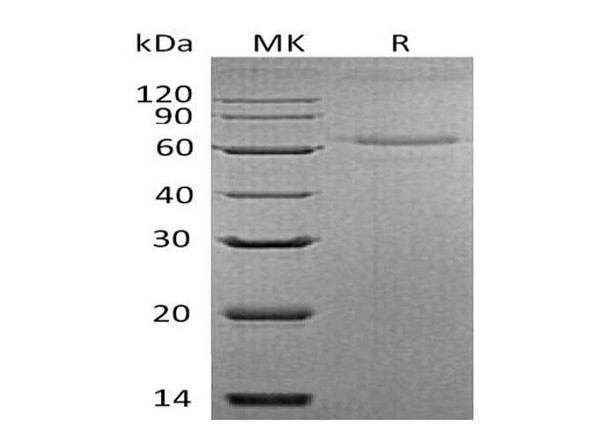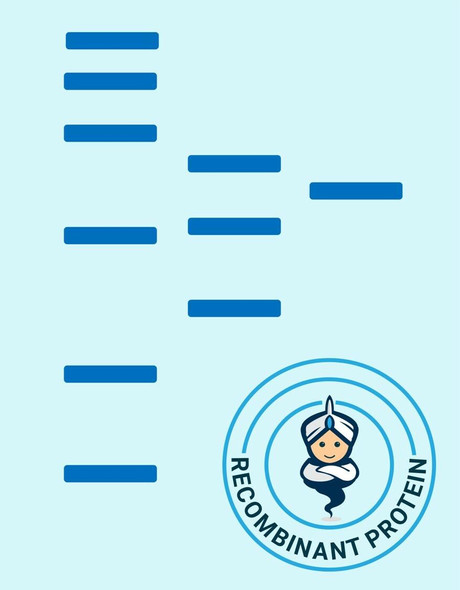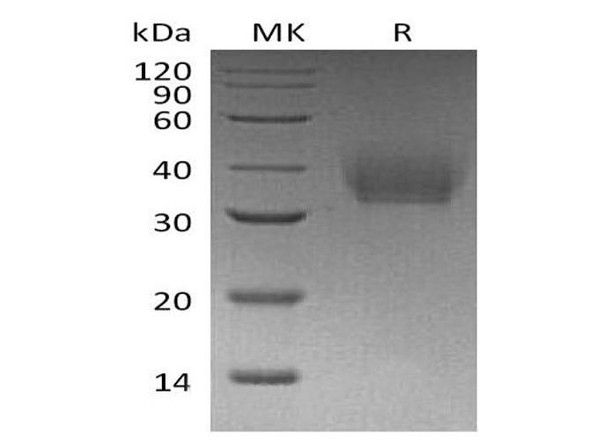Mouse IL 27 Recombinant Protein (RPPB0648)
- SKU:
- RPPB0648
- Product Type:
- Recombinant Protein
- Species:
- Mouse
- Uniprot:
- Q8K3I6
- Research Area:
- Cytokines
Description
| Product Name: | Mouse IL 27 Recombinant Protein |
| Product Code: | RPPB0648 |
| Size: | 10µg |
| Species: | Mouse |
| Target: | IL 27 |
| Synonyms: | Interleukin-30, IL-30, IL-27/p28, p28, Interleukin-27, Interleukin-27/p28, IL-27, Interleukin-27 subunit alpha, IL-27 subunit alpha, IL27-A, Il27, Il27a, IL-27p28. |
| Source: | Escherichia Coli |
| Physical Appearance: | Sterile Filtered White lyophilized (freeze-dried) powder. |
| Formulation: | Lyophilized from 10mM Sodium Phosphate (NaP) buffer pH-7.5. |
| Solubility: | It is recommended to reconstitute the lyophilized IL-27 in sterile 18M?-cm H2O not less than 100�g/ml, which can then be further diluted to other aqueous solutions. |
| Stability: | Lyophilized IL-27 although stable at room temperature for 3 weeks, should be stored desiccated below -18°C. Upon reconstitution IL27 should be stored at 4°C between 2-7 days and for future use below -18°C.Please prevent freeze-thaw cycles. |
| Purity: | Greater than 95.0% as determined by(a) Analysis by RP-HPLC.(b) Analysis by SDS-PAGE. |
| Amino Acid Sequence: | MFPTDPLSLQ ELRREFTVSL YLARKLLSEV QGYVHSFAES RLPGVNLDLL PLGYHLPNVS LTFQAWHHLS DSERLCFLAT TLRPFPAMLG GLGTQGTWTS SEREQLWAMR LDLRDLHRHL RFQVLAAGFK CSKEEEDKEE EEEEEEEEKK LPLGALGGPN QVSSQVSWPQ LLYTYQLLHS LELVLSRAVR DLLLLSLPRR PGSAWDS |
| Biological Activity: | Mouse p28 biological activity was measured via dose-dependent inhibition of TGF-beta and IL-6-induced IL-17A expression in mouse CD4 splenocytes. 50ng/ml� corresponding to a Specific Activity of 20,000IU/mg of mouse p28 is capable of inhibiting >25% of IL-17A expression in this assay. |
Interleukin-27 protein is related to IL-12A & is one of the subunits of a heterodimeric cytokine complex. IL-27 interacts with EBV induced gene 3 also called EBI3, and forms a complex that drives rapid expansion of CD4 (+) T cells. IL-27 complex is synergizes with IL-12 in order to trigger the cytokine production of IFN-Gamma of CD4 (+) T cells. The biological effect of IL-27 is mediated by class-I cytokine receptor (WSX1/TCRR). The pro-inflammatory activity of IL-27 is mediated through the growing expression of key molecules involved in the MHC class-I & MHC class-II pathways. Both MHC class-I and MHC-class-II expression are increased in endothelial cells after Interleukin-27 stimulation which suggests that it may play an important role in conferring the immune function on vascular endothelium IL-27p28 subunit can be induced by IFN-beta and during LPS-induced maturation of dendritic cells in type-I IFN-dependent manner through IFN regulatory factor-1 activation. Interleukin-27 regulates Interleukin-12 responsiveness of CD4+ T cells through Stat1-dependent and -independent mechanisms. IL-17 & IL-23 play an important IL-17 role in inflammation. Interleukin-27 possesses potent anti-angiogenic activity that plays an important role in its antitumor and antimetastatic activities. EBV induced gene 3 plays a role, independently from IL-27, in regulating anti-viral or anti-tumoral immune responses. Interleukin-27 is a potent inhibitor of HIV-1 replication in macrophages, CD4+ T cells, peripheral blood mononuclear cells. Interleukin-27 triggers STAT activation and gene transcription.
Interleukin-27 Mouse Recombinant produced in E.Coli is a single, non-glycosylated polypeptide chain containing 207 amino acids and having a molecular mass of 23.7 kDa. The Murine IL-27 is purified by proprietary chromatographic techniques.
| UniProt Protein Function: | IL27-alpha: Cytokine with pro- and anti-inflammatory properties, that can regulate T-helper cell development, suppress T-cell proliferation, stimulate cytotoxic T-cell activity, induce isotype switching in B-cells, and that has diverse effects on innate immune cells. Among its target cells are CD4 T-helper cells which can differentiate in type 1 effector cells (TH1), type 2 effector cells (TH2) and IL17 producing helper T-cells (TH17). It drives rapid clonal expansion of naive but not memory CD4 T-cells. It also strongly synergizes with IL-12 to trigger interferon- gamma/IFN-gamma production of naive CD4 T-cells, binds to the cytokine receptor WSX-1/TCCR which appears to be required but not sufficient for IL-27-mediated signal transduction. IL-27 potentiate the early phase of TH1 response and suppress TH2 and TH17 differentiation. It induces the differentiation of TH1 cells via two distinct pathways, p38 MAPK/TBX21- and ICAM1/ITGAL/ERK- dependent pathways. It also induces STAT1, STAT3, STAT4 and STAT5 phosphorylation and activates TBX21/T-Bet via STAT1 with resulting IL12RB2 up-regulation, an event crucial to TH1 cell commitment. It suppresses the expression of GATA3, the inhibitor TH1 cells development. In CD8 T-cells, it activates STATs as well as GZMB. IL-27 reveals to be a potent inhibitor of TH17 cell development and of IL-17 production. Indeed IL-27 subunit p28 alone is also able to inhibit the production of IL17 by CD4 and CD8 T-cells. While IL-27 suppressed the development of proinflammatory Th17 cells via STAT1, it inhibits the development of anti-inflammatory inducible regulatory T-cells, iTreg, independently of STAT1. IL-27 has also an effect on cytokine production, it suppresses proinflammatory cytokine production such as IL2, IL4, IL5 and IL6 and activates suppressors of cytokine signaling such as SOCS1 and SOCS3. Apart from suppression of cytokine production, IL-27 also antagonizes the effects of some cytokines such as IL6 through direct effects on T-cells. Another important role of IL-27 is its antitumor activity as well as its antiangiogenic activity with activation of production of antiangiogenic chemokines such as IP- 10/CXCL10 and MIG/CXCL9. In vein endothelial cells, it induces IRF1/interferon regulatory factor 1 and increase the expression of MHC class II transactivator/CIITA with resulting up-regulation of major histocompatibility complex class II. IL-27 also demonstrates antiviral activity with inhibitory properties on HIV-1 replivation. Belongs to the IL-6 superfamily. |
| UniProt Protein Details: | Protein type:Cytokine; Secreted, signal peptide; Secreted Cellular Component: extracellular space; extracellular region Molecular Function:protein binding; interleukin-27 receptor binding; cytokine activity; receptor binding Biological Process: regulation of T-helper 1 cell differentiation; immune system process; regulation of T cell proliferation; innate immune response; inflammatory response; positive regulation of interferon-gamma biosynthetic process |
| UniProt Code: | Q8K3I6 |
| NCBI GenInfo Identifier: | 81866680 |
| NCBI Gene ID: | 246779 |
| NCBI Accession: | Q8K3I6.1 |
| UniProt Related Accession: | Q8K3I6 |
| Molecular Weight: | 26,542 Da |
| NCBI Full Name: | Interleukin-27 subunit alpha |
| NCBI Synonym Full Names: | interleukin 27 |
| NCBI Official Symbol: | Il27�� |
| NCBI Official Synonym Symbols: | p28; Il30; IL-27; IL-27p28�� |
| NCBI Protein Information: | interleukin-27 subunit alpha; IL27-A; IL-27-A; interleukin 30; IL-27 p28 subunit; IL-27 subunit alpha |
| UniProt Protein Name: | Interleukin-27 subunit alpha |
| UniProt Synonym Protein Names: | p28 |
| Protein Family: | Interleukin |
| UniProt Gene Name: | Il27�� |
| UniProt Entry Name: | IL27A_MOUSE |










